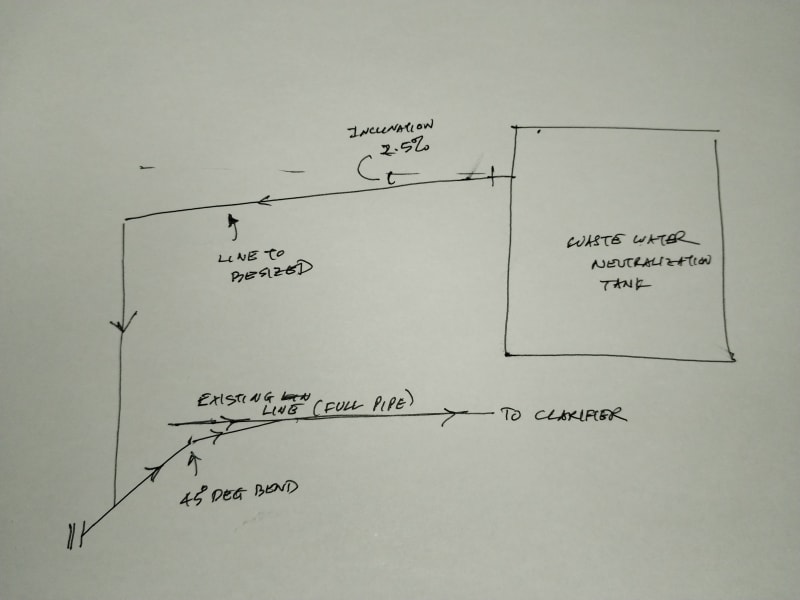Pavan Kumar
Chemical
Hi All,
I am tasked to size the overflow line from tank. The line, that is supposed to be sized, comes out from the side outlet has a near horizontal run of 14 ft before it turns 90 degree down and travels 15 ft down and then turns horizontal ( 12 ft run) and connects to main header which is always liquid full. Process data is as below.

Flow Rate = 3300 gpm
Fluid = water
Temp = 20 Deg C
Density = 62.3160 lb/ft3
Viscosity = 1 cP
Incline = 2.5 %
Pipe fill = 1/2 full
Pipe roughness = 0.0018 inches
I am trying to use the eqn (5) in PD Hills Paper to calculate velocity
VL = (32g*m*i)^(1/2) * Log{ [(e/(14.8m)] + [0.22 u/ (m(g*m*i)^1/2)]}
where
g= gravitational constant in consistent units.
m = hydraulic mean depth = Flow Area / wetted perimeter
i = inclination
e = pipe roughness
u = kinematic viscosity, in consistent units.
I set-up an excel calculation sheet, however I am getting velocity as negative. I am trying to find out what is going wrong and need help here. Also I want to test this formula using the curve given in Fig 3 of PD Hills paper. My reason for using this equation, as opposed to using the curves, is to try different slopes and different liquid depths in the pipe.
Any help will be great help to me.
Thanks and Regards,
Pavan Kumar
I am tasked to size the overflow line from tank. The line, that is supposed to be sized, comes out from the side outlet has a near horizontal run of 14 ft before it turns 90 degree down and travels 15 ft down and then turns horizontal ( 12 ft run) and connects to main header which is always liquid full. Process data is as below.

Flow Rate = 3300 gpm
Fluid = water
Temp = 20 Deg C
Density = 62.3160 lb/ft3
Viscosity = 1 cP
Incline = 2.5 %
Pipe fill = 1/2 full
Pipe roughness = 0.0018 inches
I am trying to use the eqn (5) in PD Hills Paper to calculate velocity
VL = (32g*m*i)^(1/2) * Log{ [(e/(14.8m)] + [0.22 u/ (m(g*m*i)^1/2)]}
where
g= gravitational constant in consistent units.
m = hydraulic mean depth = Flow Area / wetted perimeter
i = inclination
e = pipe roughness
u = kinematic viscosity, in consistent units.
I set-up an excel calculation sheet, however I am getting velocity as negative. I am trying to find out what is going wrong and need help here. Also I want to test this formula using the curve given in Fig 3 of PD Hills paper. My reason for using this equation, as opposed to using the curves, is to try different slopes and different liquid depths in the pipe.
Any help will be great help to me.
Thanks and Regards,
Pavan Kumar
